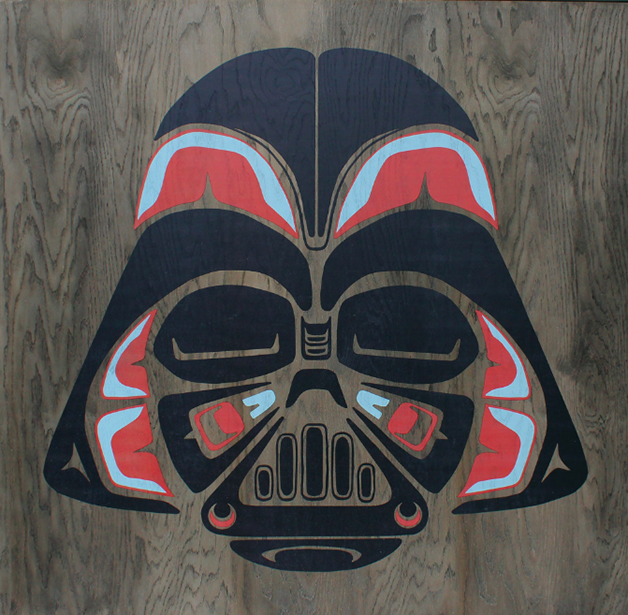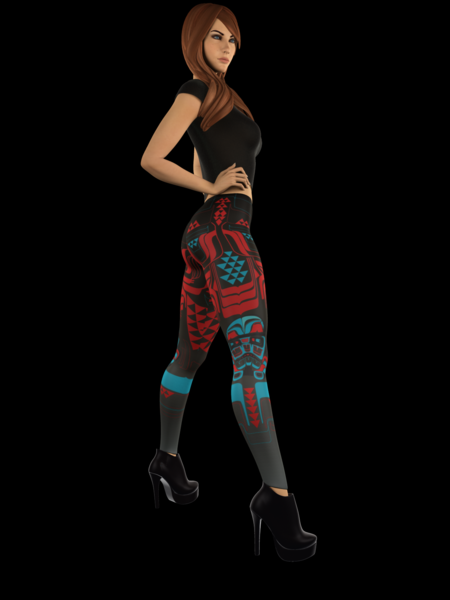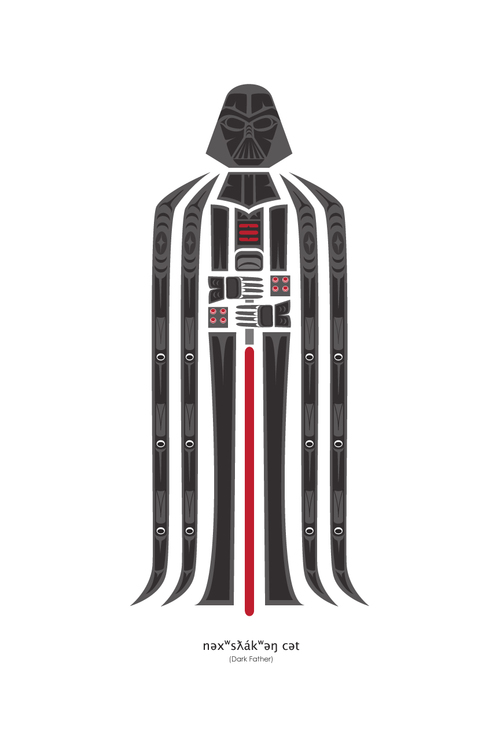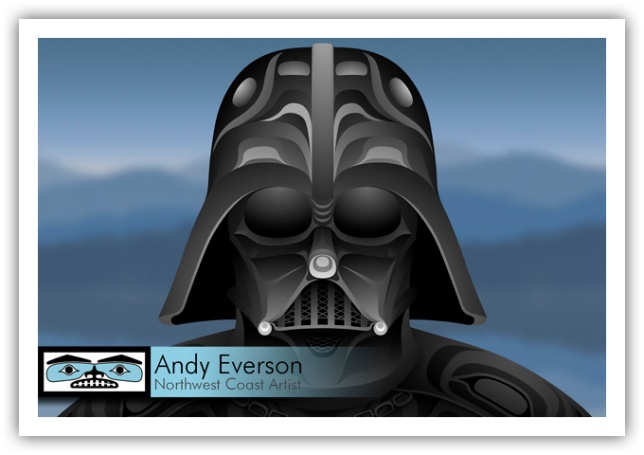So this is what inspired me to write a blog post for the first time in a long time. (Life has been busy.) I ran across a post on Facebook regarding a show (Rebellion Alliance) that this artist recently had in Seattle. Although the artist is white, I wasn’t too disturbed at first glance. It just didn’t seem like anything new to me since I’ve seen work in this theme done by native artists already. But in taking a closer look at the site, and really getting into the statement for the show, I started to have some serious misgivings. Technically, the artist isn’t doing anything illegal if he isn’t marketing his work as “Indian.” And while there are some who feel that artists from other cultures shouldn’t work in this type of style, I feel like the cross-cultural influence works both ways, so I don’t personally have a problem with someone creating work like this as long as they aren’t trying to pass it off as work by a native artist. Then I got to his statement about the show (excerpts below) and I started having some serious issues.
“Animals frequently observed in this part of the world are depicted with intrinsic sacredness. The integrity of these ancient forms has not only endured, but also increased in power amidst an over-saturated advertising media age.” “A bridge….between a divisive past of non-dignifying cultural theft to our present role in imagineering a more hopeful future. Where we simultaneously restore honor due to the cultural sources of storytelling and their art techniques, while exploring our individual and shared narratives with imagination, innovation, and creative freedom.”
After reading the statement, and then reading it again, I’m like, “OH, HELL NO!” My initial personal opinion is that his statement is really long and way too filled with “artspeak.” But that aside, he also is not only romanticizing the usual stereotypes of native people, he also is claiming to have some sort of magic power to bring opposing cultures together. I think he is filled with great intentions. I also think he is full of shit and needs to be more thorough with his research and presentation if he really believes what he is saying here. You know, “Me white man. Me able to build bridges between whites and natives with art. You be honored by my appropriation of your culture.” I would like to appreciate what he is trying to do, but he is in tricky territory and he hasn’t done his homework. For instance, there is also a FAQ page that offers such information as:
“As you can imagine, after the initial thrill of discovering through this process, that these images were visually compelling, it soon set in that they also served as guideposts to deeply significant conceptual and subsequent potentially sacrilegious cultural commentary, ushered in by their bridges between pop and sacred, and the appropriative and anthropological questions they spark, made creating them increasingly uncomfortable for the artist, a non-Native American.” “Prior to exhibiting the work, select local members of Indigenous Tribes considered the show’s purpose and images, and share in the hope that the approachability of the works spark a conversation that encourages us all to investigate together the questions the works raise afresh, and anticipate the exhibition will generate greater appreciation and support of Indigenous Tribal art, culture, and people. Though no objections were made, they cannot, nor do they ascribe to, speak for everyone. They informally welcomed 10% of the show proceeds to support Indigenous youth arts education, and recommended formal presentation of the works to Tribal elders for consideration, a conversation that will continue after the work’s initial private and public debut.” “Try to contribute personal and fresh perspectives vs.generalizations or thoughts that you’re positive have already been voiced, and help spread the word that this show is intended as a forum where we can all learn from each other.”
Dude. Again, he really needs to edit all of this down. Also, is this a continuation of his statement? Because it was not in what I would expect from a FAQ format. I’m really curious who these “select local members of Indigenous Tribes” were. The artist is from Portland. Were they from Oregon tribes? Washington Tribes, since the show is in Seattle? If he wasn’t even willing to wait until his work had been presented to Tribal Elders for consideration before publicly displaying and selling his work, why bother to even make the effort to seek input from tribal members? Also, who selected this “select” group? I can only assume it was the artist, himself… Additionally, there is no mention that formline design is actually from tribes much farther north than Portland or Seattle. I get that he is bringing two influences from his childhood, Star Wars and the Coast Salish artwork that is easily found in his hometown of Seattle (totem poles especially), together in what he thinks is a new and interesting way. Yet, this ubiquitous public art in Seattle had already been appropriated by whites who brought it down from tribes in B.C. and Alaska. Oh yeah, and there are already native artists doing THE EXACT SAME THING that he apparently knows nothing about. More on those artists in a minute. HOWEVER…
Then I went back to the main page and discovered a link to a page that is selling these leggings. I dug around a little more and it suddenly started to make more sense. The show was put on by Bombsheller Art Labs, which apparently specializes in print-on-demand personalized fashions (leggings).
“Bombsheller Art Labs is a new kind of maker gallery……a “collaborative” gallery… where designer/artists and patrons are empowered to create, innovate, and exchange skills and ideas. Generating both art community and art commerce, Bombsheller Arts Labs exhibits an eclectic selection of works, installations and performances, with an emphasis on tech and fashion influenced works created primarily by local Northwest artists.”
Now I think the whole thing is even worse. Why? Well, that would have to do with the issue of indigenous women’s rights, which is really a whole other post. I could go on and on about stereotypes of Native women and how damaging they are. The image above, well, it just feeds into that whole trope of the hyper-sexualized, exotic Indian Princess. But rather than go down that road, here’s a quick statistic from Amnesty International:
“Sexual violence against Indigenous women in the USA is widespread. According to US government statistics, Native American and Alaska Native women are more than 2.5 times more likely to be raped or sexually assaulted than other women in the USA.”
So now the artist is putting on a show of artwork that he readily admits he has appropriated from another culture, without any information on the original tradition or cultures that he has borrowed from. He is deflecting this appropriation and any issues that people may have with it by: 1) Donating 10% of the show proceeds to Indigenous Youth Arts Programs, which implies that he is trying to preemptively atone for some sort of misdeed; 2) Stating that he has asked for permission from “select” tribal members and then, instead of waiting for that process to play out entirely and get any formal endorsement, he has gone ahead with public display and sale of the work by calling it an “unfinished” exhibition and the beginning of a narrative; and 3) His artwork, which has been appropriated from indigenous traditions, is being applied to leggings which are marketed in a highly sexualized manner which only further encourages negative and sexually-charged stereotypes relating to Native American and First Nations women. Those leggings? I. Can’t. Even. Deal. Here is the text that accompanies them:
“Flaunt or flaunt not. There is no try, cuz these Troopers are made for marchin’. Symmetrically rendered patterns help you strut like dunkards drink and killas kill….Yoda always used to say. #TrooperVibe shell design is inspired by Alliance Is Rebellion art show, an alternative universe created by Scott Erickson, bridging a satirical spin on a “mainstream” space epic and an homage to Indigenous Pacific Northwest Tribal iconic art techniques to create a new force you can flaunt.”
Just, no. This is not an homage. This is not respectful. This is just another version of the hipster headdress. Or the Urban Outfitters Navajo Hipster Panty. There are so many other examples I could list. Sure, the artist isn’t doing anything illegal. But distasteful? Yes. His goal is starting to feel less like “a bridge” and more like making a profit. (Which I get, because hey, we’ve all got to survive, right?) Just don’t pretend that the main point of this exhibit is to build a bridge and then go and align yourself with a company that will monetize your artwork in a really crass way. So. Now a few words of personal advice to Scott Erickson on what he might do to improve on this project: 1) DON’T MAKE GRAND STATEMENTS THAT YOU CAN’T ACTUALLY FULFILL. Yes, your artwork does help link two worlds together. That is great. No, you are not the first artist to attempt this. Maybe just explore how you are combining these two things together, and really focus in on that specific intersection rather than go in a direction where you are trying to “identify and question what’s sacred in both culture and art.” Which leads to… 2) EDIT, EDIT, EDIT! You do not need a statement that is longer than a few paragraphs. You also do not need a FAQ page that reads like an artist statement. Distill things down to their essence. Create one really strong sentence you can lead with that would allow a reader to understand what this show is about. Don’t assume your audience at your exhibition (in-person OR online) will read everything you write. Be concise. (I recognize that I am telling you to edit things down on a blog post that has grown dangerously long, but that is also because, well, this is a personal blog that I only sporadically post on. If I were writing this for any sort of professional publication, you can bet that I would pare things down and spend a lot of time editing rather than just write for an hour and hit “post.”) 3) DO YOUR HOMEWORK. This is probably my biggest piece of advice. Especially if you are going to be creating work in what you acknowledge is controversial territory. If you are going to appropriate traditions that are not your own, be prepared to cite your sources and influences. Don’t substitute conceptual statements for hard facts. Don’t vaguely refer to “the indigenous tribes of the Pacific Northwest Coast,” you need to know some names of specific cultures, tribes, and even artists. Don’t call something sacred without having at least some sort of understanding about why it is sacred, and who it is sacred to. Also don’t assume that your own “initial thrill” of discovering a process of combining formline design with Star Wars means that you are the first person to arrive at this point. A cursory search of the amazing internets would have likely introduced you to work by at least one of the following two artists. I can only assume you didn’t know about their work already when you were putting this exhibit together?
Jeffrey Veregge is an artist I’ve had the pleasure of meeting in person. I really love his work, and I’ve seen him go from a style he called “Salish Expressionism” to his current line of work that is “a reflection of a lifetime love affair with comic books, toys, TV and film.” He also has worked with Star Wars as inspiration as shown by the image above. On his website with this image is the following text: “My first use of S’Klallam in a piece. This piece is currently with LucasFilm Licensing for approval for an official Salish Geek Star Wars Print.” I’m not certain of the date he made it, but it is either from 2014 or 2013.
Andy Everson is an artist I follow on Facebook. In 2012, he created the image above. Looks familiar, eh? Amusingly enough, he also posted a link on his page today to a blog entry by another Native artist, Shaun Peterson (Puyallup) that addresses this exact subject and also includes comparative images of Erickson’s work alongside Veregge’s and Everson’s. Not only are the side-by-side comparisons worth a look, Peterson writes about the expectations that Native artists have to deal with quite eloquently.

There is hope, if we rise, 2013: by Sonny Assu (Liǥwildaʼx̱w (We Wai Kai) of the Kwakwaka’wakw nations).
I also wanted to include an image of Sonny Assu‘s work here. While he hasn’t (to my knowledge) produced any Star Wars inspired artwork, he is yet another contemporary Native artist who is interpreting formline design in new ways. Okay, I’m almost done here. So yeah, this is what Scott Erickson says about this body of work:
“These pieces, which I made purely for the joy of it, explore new connections between sacred Indigenous Northwest storytelling, and familiar “mainstream” cultural narratives. My hope is to share their power and encourage us to build the bridges they represent.”
But these are not new connections being made. They have been made already, repeatedly, by Indigenous artists. Erickson also asks:
“Personally and plainly: How am I not just another white guy stealing from the native tribes for my own benefit? Is this imitation considered the best form of flattery? How do I give honor where honor is due?”
Scott, I’m so sorry to have to tell you this. Right now, you are “just another white guy stealing from the native tribes for [your] own benefit.” Better luck next time.




